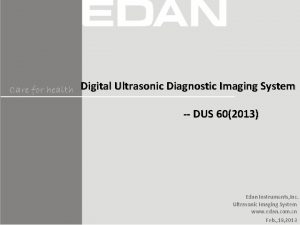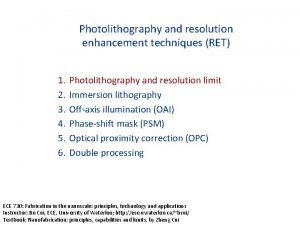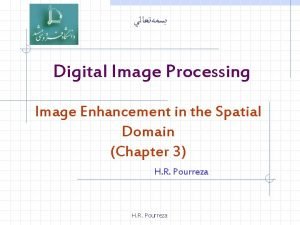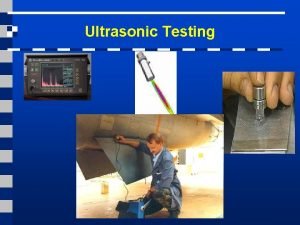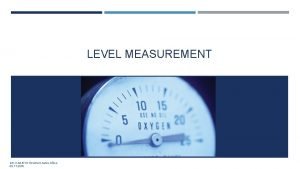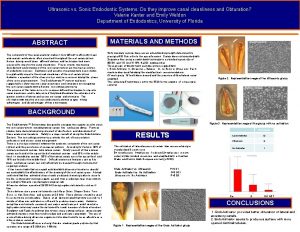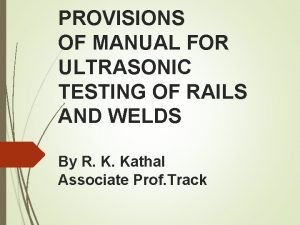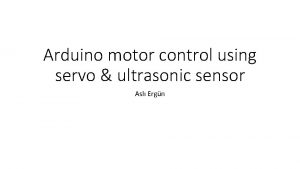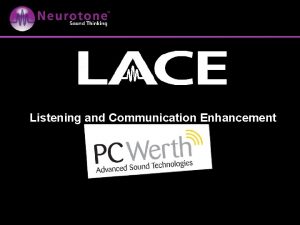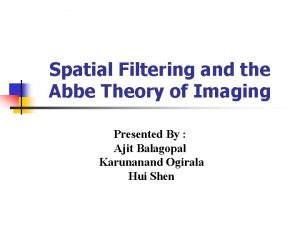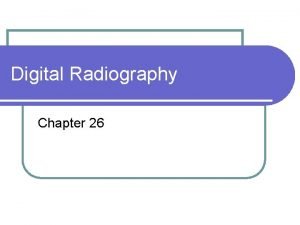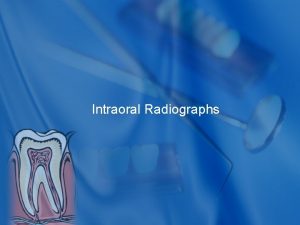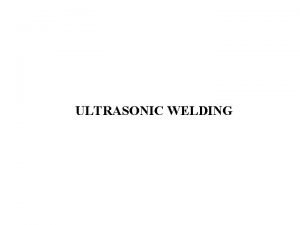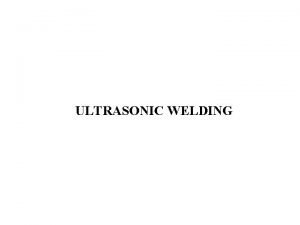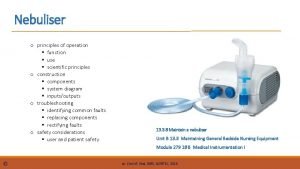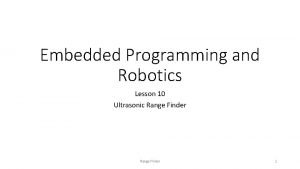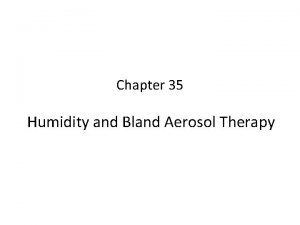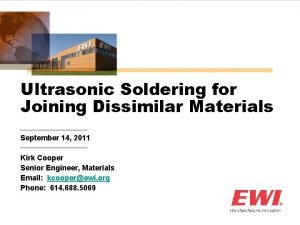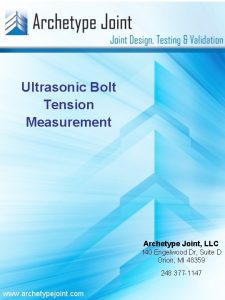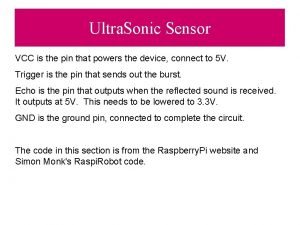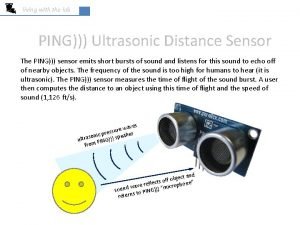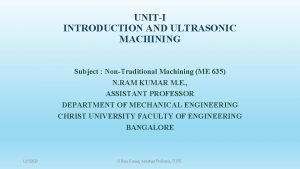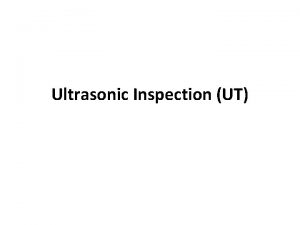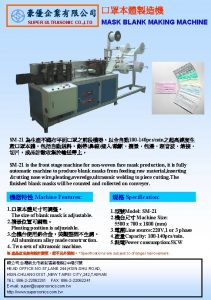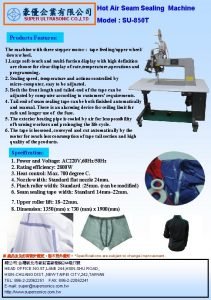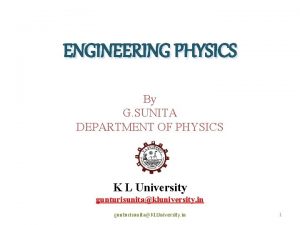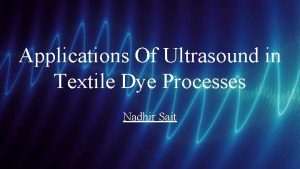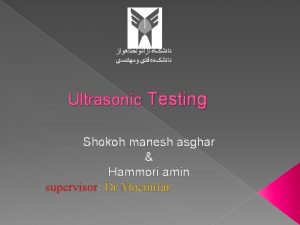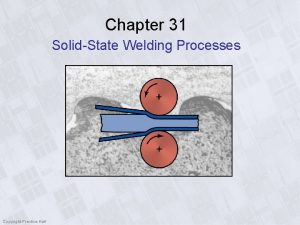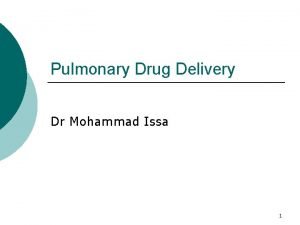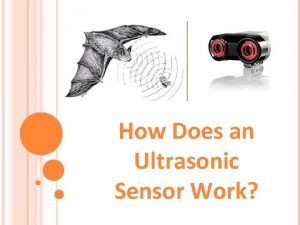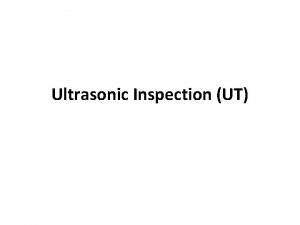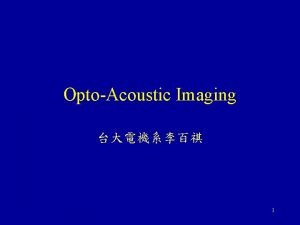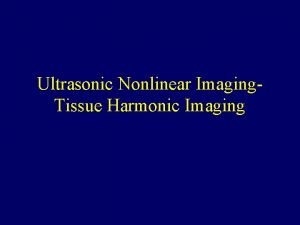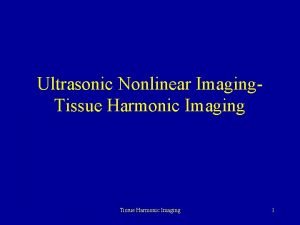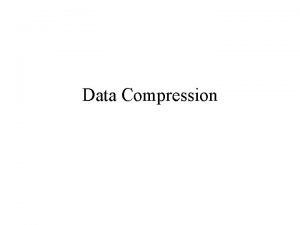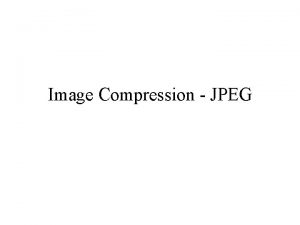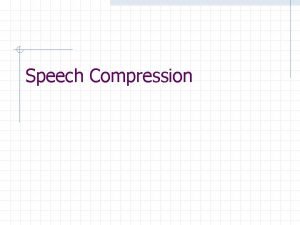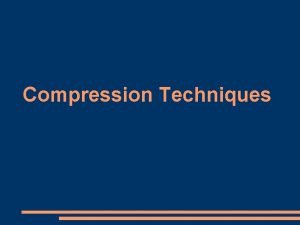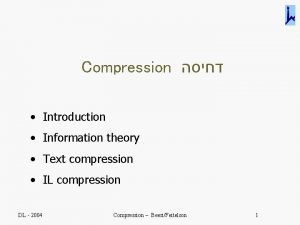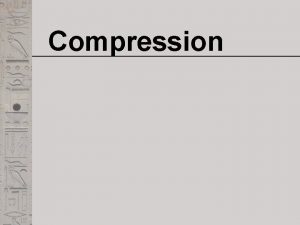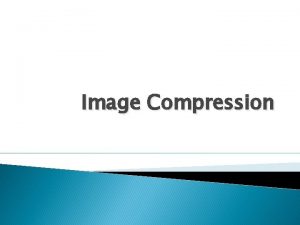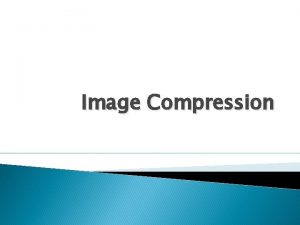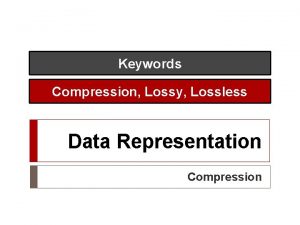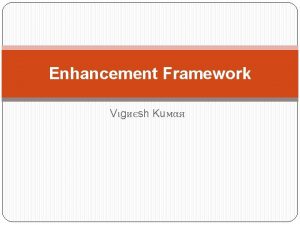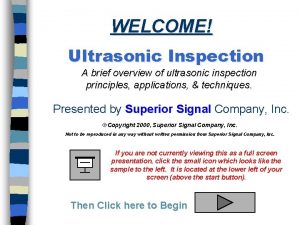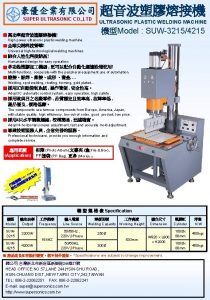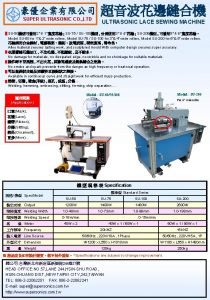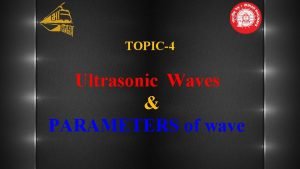Ultrasonic Imaging using Resolution Enhancement Compression and GPUAccelerated






































![References [1] [2] [3] [4] [5] M. Oelze, “Bandwidth and resolution enhancement through pulse References [1] [2] [3] [4] [5] M. Oelze, “Bandwidth and resolution enhancement through pulse](https://slidetodoc.com/presentation_image_h/1d8df79c7913c51743b9bc39da83cb23/image-39.jpg)





- Slides: 44

Ultrasonic Imaging using Resolution Enhancement Compression and GPUAccelerated Synthetic Aperture Techniques Presenter: Anthony Podkowa May 2, 2013 Advisor: Dr José R. Sánchez Department of Electrical and Computer Engineering

Outline I. II. A. B. III. IV. Motivation & project summary Block diagram REC GSAU Results Areas of Expansion 2

Outline I. II. A. B. III. IV. Motivation & project summary Block diagram REC GSAU Results Areas of Expansion 3

Motivation Key medical imaging technique n Tumor detection n Seek to improve n Spatial resolution n Signal-to-noise ratio (SNR) n 4

Project Summary n n Resolution enhancement compression (REC) n Coded excitation and pulse compression technique n Improved axial resolution n Improved SNR Generic synthetic aperture ultrasound (GSAU) n Synthetic aperture technique n Improves lateral resolution n Improves SNR n Computationally expensive, but parallelizable 5

Goals: 1. To investigate the combination of both REC and GSAU in an ultrasound system using MATLAB and Field II. 2. To accelerate the GSAU algorithm using a graphics processing unit (GPU) to achieve real-time processing of the images. 6

Outline I. II. A. B. III. IV. Motivation & project summary Block diagram REC GSAU Results Areas of Expansion 7

System Block Diagram Vpc(t) Vin(t) Encoder Received Echo Signals Transducer 256 Compressed Signals Wiener Filter Beamformed Signals GSAU 256 Image Recon. Image Output 256 Vlc(t) 8

Outline I. II. A. B. III. IV. Motivation & project summary Block diagram REC GSAU Results Areas of Expansion 9

Resolution Enhancement Compression Vpc(t) Vin(t) Encoder Received Echo Signals Transducer 256 Compressed Signals Wiener Filter 256 Vlc(t) n n n Based on the convolution equivalence principle Encoder shapes excitation signal Wiener Filter: n n Compresses the received signals Removes corrupting noise 10

Convolution Equivalence Principle Some input Some other input Desired system Transducer Desired Response n n n Make ht(t) act like hd(t) by shaping v 1(t) Wiener deconvolution. 11

Encoder Subsystem Vulc(f) Wiener Deconvolution Filter Vupc(f) Tukey Window Vpc(f) Inverse Filter Vlc(f) 12

Encoder Subsystem Vulc(f) Wiener Deconvolution Filter Vupc(f) Tukey Window Vpc(f) Inverse Filter Vlc(f) 13

Encoder Subsystem Vulc(f) Wiener Deconvolution Filter Vupc(f) Tukey Window Vpc(f) Inverse Filter Vlc(f) 14

Encoder Subsystem Vulc(f) Wiener Deconvolution Filter Vupc(f) Tukey Window Vpc(f) Inverse Filter Vlc(f) 15

System Block Diagram Vpc(t) Vin(t) Encoder Received Echo Signals Transducer 256 Compressed Signals Wiener Filter Beamformed Signals GSAU 256 Image Recon. Image Output 256 Vlc(t) 16

Transducer Specifications n n n n 256 elements 8 MHz center frequency 200 MHz sampling frequency 4 mm element height Height 0. 26 mm element width 0. 04 mm element kerf 20 mm focus Kerf Width 17

System Block Diagram Vpc(t) Vin(t) Encoder Received Echo Signals Transducer 256 Compressed Signals Wiener Filter Beamformed Signals GSAU 256 Image Recon. Image Output 256 Vlc(t) 18

Outline I. II. A. B. III. IV. Motivation & project summary Block diagram REC GSAU Results Areas of Expansion 19

GSAU Technique n n Transmit and receive with one element at a time. Calculate delays associated with the distances from element to each pixel: 256 x 30000 pixels Parallel processing 20

GPU Programming (CUDA) Up to 8 cores Host Device Hundreds of cores Memory Transfer 21

CUDA C n n n n Allocate data memory on device Copy data from the host memory to the device Spawn several threads to process the data Each thread runs the same chunk of code (kernel) Each thread processes the pixel corresponding to its thread index. Copy data back from device memory Free device memory 22

Test Hardware Specifications n CPU: Intel Core i 7 -2600 K 4 Cores n Processor Clock: 3. 4 GHz n RAM: n GPU: n 16 GB NVIDIA Quadro 5000 352 CUDA cores n Processor Clock: n RAM: n Memory Bandwidth: n 1026 MHz 2560 MB GDDR 5 120 GB/s 23

System Block Diagram Vpc(t) Vin(t) Encoder Received Echo Signals Transducer 256 Compressed Signals Wiener Filter Beamformed Signals GSAU 256 Image Recon. Image Output 256 Vlc(t) 24

Image Reconstruction Subsystem Beamformed Signal Envelope Detection Logarithmic Compression Image Scan Line Limiter 25

Outline I. Motivation & project summary II. Block diagram A. REC B. GSAU III. Results IV. Areas of Expansion 26

Simulation Settings Point imaged at 20 mm n Tukey window taper: α = 0. 08 n γ = 1 (Wiener filter) n Additive noise injected (σn = 0. 1 σs) n Excitation schemes studied: n REC n Conventional pulsing (Delta function) n 27

Encoding n n Linear chirp: n 0 – 17. 12 MHz n 12. 5 μs Desired Response: n 200% BW Transducer Response: n 100% BW MSE: 4. 46 x 10 -7 28

GPU Acceleration n GPUs perform faster usingle precision 4. 5% round off error Computation time decreased from 29. 25 s to 0. 25 s 29

Wiener Filter n n Received signals compressed axially 3 d. B gain in SNR 30

REC + GSAU n n Received signals compressed laterally 5 d. B gain in SNR 31

CP + GSAU n n n Received signals compressed laterally SNR loss of 0. 3 d. B 10 d. B less SNR than REC + GSAU, and 5 d. B less than REC alone 32

Resolution Analysis n n Resolution computed from the modulation transfer function (MTF) MTF is the spatial Fourier transform of the point spread function (PSF). Critical wavenumber k 0 computed by determining the point where normalized MTF crosses 0. 1 Resolution given by: 33

Axial Resolution n n CP: 0. 52022 mm REC: 0. 44062 mm CP+GSAU: 0. 54117 mm REC+GSAU: 0. 64507 mm 34

Lateral Resolution n n CP: 0. 28149 mm REC: 0. 29489 mm CP+GSAU: 0. 10321 mm REC+GSAU: 0. 10321 mm 35

Outline I. Motivation & project summary II. Block diagram A. REC B. GSAU III. Results IV. Areas of Expansion 36

Potential Areas of Expansion n GSAU Improved interpolation (linear, polynomial) n Alternative reweighting schemes n n Other SA techniques: Synthetic transmit aperture ultrasound (STAU) n Synthetic receive aperture ultrasound (SRAU) n n GPU speedup Use of optimized libraries (CUBLAS, MAGMA) n Reduce thread overhead n 37

Conclusions n n n REC + GSAU exhibit the best performance in SNR. CP + GSAU exhibit the best performance in spatial resolution. GPU acceleration results in a speedup by a factor of 116. 38
![References 1 2 3 4 5 M Oelze Bandwidth and resolution enhancement through pulse References [1] [2] [3] [4] [5] M. Oelze, “Bandwidth and resolution enhancement through pulse](https://slidetodoc.com/presentation_image_h/1d8df79c7913c51743b9bc39da83cb23/image-39.jpg)
References [1] [2] [3] [4] [5] M. Oelze, “Bandwidth and resolution enhancement through pulse compression, ” IEEE Trans. Ultrason. , Ferroelec. , and Freq. Contr. , vol. 54, no. 4, pp. 768 -781, Apr. 2007. J. Sanchez and M. Oelze, “An ultrasonic imaging speckle-suppression and contrast-enhancement technique by means of frequency compounding and coded excitation, ” IEEE Trans. Ultrason. , Ferroelec. , and Freq. Contr. , vol. 56, no. 7, pp. 1327 -1339, Jul. 2009. S. Nikolov, “Synthetic aperture tissue and flow ultrasound imaging, ” Ph. D. dissertation, Technical University of Denmark, 2001. [Online]. Available: https: //svetoslavnikolov. wordpress. com/synthetic-aperture-ultrasound-imaging/ J. Jensen, “Field: A program for simulating ultrasound systems, ” in Medical & Biological Engineering & Computing, vol. 34, 1996, pp 351 -353 J. Jensen, and N. Svendsen, “Calculation of pressure fields from arbitrary shaped, apodized, and excited ultrasound transducers, ” IEEE Trans. Ultrason. , Ferroelec. and Freq. Contr. 39

Ultrasonic Imaging using Resolution Enhancement Compression and GPUAccelerated Synthetic Aperture Techniques Presenter: Anthony Podkowa May 2, 2013 Advisor: Dr José R. Sánchez Department of Electrical and Computer Engineering

Importing into MATLAB n n n Generate PTX file from CUDA code Initialize kernel object using PTX file Convert input data to a gpu. Array Evaluate kernel Bring the output data back using the gather() function 41

Derivation of Envelope Detection 42

Apodization n Spatial Windowing Used to shape the beam profile Reweighting by apodization coefficients a 1 a 2 a. N 43

Generic Synthetic Aperture Ultrasound Electrically focus signals to create an artificial aperture. n Pros: n Improved lateral resolution. n Improved SNR. n n Cons: n Computationally expensive. 44
 Digital ultrasonic diagnostic imaging system
Digital ultrasonic diagnostic imaging system Frc control system
Frc control system Resolution of photolithography
Resolution of photolithography Mask mode radiography
Mask mode radiography High resolution low resolution
High resolution low resolution Audio super resolution using neural networks
Audio super resolution using neural networks Image super resolution using deep convolutional networks
Image super resolution using deep convolutional networks Audio super resolution using neural networks
Audio super resolution using neural networks Ultrasonic testing principle
Ultrasonic testing principle Hook type level measurement
Hook type level measurement Sonic and ultrasonic in endodontics
Sonic and ultrasonic in endodontics Dfwo and dfwr full form
Dfwo and dfwr full form Ultrasonic servo arduino
Ultrasonic servo arduino Centre for learning enhancement and research
Centre for learning enhancement and research Listening and communication enhancement
Listening and communication enhancement Environmental enhancement and mitigation program
Environmental enhancement and mitigation program Princeton imaging and analysis center
Princeton imaging and analysis center Abbe imaging and spatial filtering experiment
Abbe imaging and spatial filtering experiment Chapter 39 digital imaging film and radiographs
Chapter 39 digital imaging film and radiographs Chapter 39 digital imaging film and radiographs
Chapter 39 digital imaging film and radiographs Ultrasonic welding terminology
Ultrasonic welding terminology Ultrasonic welding definition
Ultrasonic welding definition Jet nebulizer vs ultrasonic nebulizer
Jet nebulizer vs ultrasonic nebulizer Ultrasonic nebulizer working principle
Ultrasonic nebulizer working principle Ultrasonic range finder definition
Ultrasonic range finder definition Bland aerosol therapy indications
Bland aerosol therapy indications Ultrasonic soldering iron
Ultrasonic soldering iron Bolt tension meter
Bolt tension meter Sensor vcc
Sensor vcc Ping ultrasonic distance sensor
Ping ultrasonic distance sensor Sonoxide ultrasonic water treatment
Sonoxide ultrasonic water treatment Chapter 15:3 washing hands
Chapter 15:3 washing hands Ultrasonic machining module
Ultrasonic machining module Ut definition
Ut definition Ultrasonic mask blank machine
Ultrasonic mask blank machine Ultrasonic seam sealing machine
Ultrasonic seam sealing machine Magnetostriction method diagram
Magnetostriction method diagram Ultrasonic textile dye homogenizer
Ultrasonic textile dye homogenizer Arduino ultrasonic emitter
Arduino ultrasonic emitter Immersion testing water path
Immersion testing water path Ultrasonic sensor introduction
Ultrasonic sensor introduction Ultrasonic roll seam welding
Ultrasonic roll seam welding Chapter 15:3 washing hands
Chapter 15:3 washing hands Ultrasonic nebulizer
Ultrasonic nebulizer How does the ultrasonic sensor work
How does the ultrasonic sensor work
